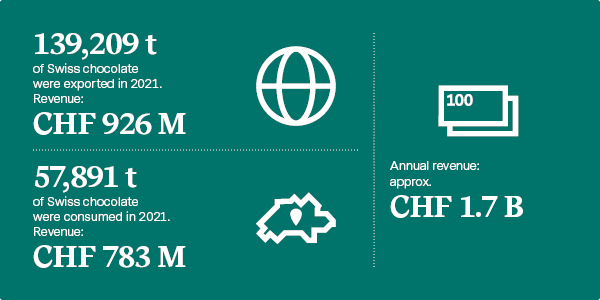Swiss Chocolate: A Sweet Investment
Volt NewsWhat it’s about
- Switzerland is known for its high-quality chocolate. But many people are not aware of the powerful economic engine behind the Swiss chocolate industry.
- According to Chocosuisse, Swiss chocolatiers have reached an annual turnover of CHF 1.7 billion in 2021. However, the number might be much higher.
- Demand for Swiss chocolate could continue to grow in the future for four reasons: Innovation, tradition, premiumization and expansion.
A land of milk and honey in the heart of Europe: As the homeland of chocolate pioneers such as François-Louis Cailler, Rudolf Sprüngli and Rodolphe Lindt, Switzerland is one of the largest and most famous chocolate manufacturers in the world. In 2021 alone, domestic chocolate producers were able to achieve an industry turnover of CHF 1.7 billion. Compared to the previous year, this corresponds to a growth of +11.8 percent.
The demand for Swiss chocolate does not only appear to be steady - it is even growing year by year.
"Made in Switzerland" is recognized as a seal of quality all around the world. And Swiss chocolate is also held in high esteem. The history of the Swiss chocolate industry dates to the 19th century, when Swiss chocolatiers revolutionized chocolate production with their inventions. The conching machine, which turned the once granular chocolate into a soft-melting paste? Invented by Rudolf Lindt. The chocolate bar as we know it today? First discovered by François-Louis Cailler. No question, Switzerland and chocolate belong together. Today, renowned chocolate and cocoa companies such as Lindt & Sprüngli, Cailler and Barry Callebaut are exporting the chocolate culture from Switzerland and have made a billion-dollar business out of their affinity for high-quality chocolate.
The Swiss Chocolate Industry in Numbers

Sources: Lindt & Sprüngli, House of Switzerland, Chocosuisse
Switzerland is one of the largest exporters of chocolate in the world. With its exports alone, Swiss chocolate and cocoa companies were able to generate sales of CHF 926 million in 2021. This corresponds to 139,209 tons of chocolate sold during this period.
But the Swiss themselves also seem to like their chocolate. Last year, 57,891 tons of Swiss chocolate were consumed in Switzerland alone. This has generated sales of CHF 783 million for domestic companies. If you add this value to that of the exports, you get an annual turnover of 1.7 billion CHF - but in reality, it could be much more.
The values are based only on the 18 companies that are registered members of Chocosuisse, the association of Swiss chocolate manufacturers. These include Swiss subsidiaries of internationally active companies such as Barry Callebaut and Lindt & Sprüngli. Not considered are the sales of other regional branches and subsidiaries of the two chocolatiers that are not registered in Switzerland. Otherwise, the figures would be even higher: Lindt & Sprüngli AG alone could generate annual sales of over CHF 4.6 billion in 2021.
4 Reasons to Invest in Swiss Chocolate
Chocolate is not only a must-have for consumers, but also for investors who are looking for a traditional industry with growth potential. On the one hand, the Swiss chocolate industry is known for classics such as golden Easter bunnies; on the other hand, Swiss chocolatiers are taking on an increasingly important role as drivers of innovation. In addition, the number of Swiss chocolatiers in the luxury segment is increasing, opening up new markets and customer groups. Further opportunities are also emerging abroad, as demand for Swiss chocolate is rising in more and more countries.
1. Innovation
In a society that is paying more attention to self-optimization and fitness, chocolate should really have no part to play. Yet, the sales figures of Swiss chocolate manufacturers are soaring. How can this be explained? In a nutshell: new creations for new target groups.
Those who decided to give up chocolate because of their lifestyle can now find the right chocolate for their needs. Meanwhile, sugar-free or vegan chocolates are not uncommon in Switzerland. Made by manufacturers such as Chocolatier Halba, Stella Bernrain, Lindt & Sprüngli and Camille Bloch, these are available in Switzerland and sold in supermarkets.
Dark chocolate has gained popularity in recent years. Those, who are more aware of their own health and prefer to consume chocolate consciously, are more likely to reach for dark chocolate because it is considered healthier due to its high cocoa content. Swiss chocolatiers are responding to the rising demand by expanding their range of dark chocolate in a fairly short time: With different cocoa percentages, enriched with mint, orange or other flavors.
Swiss chocolatiers show their ability to innovate not only by launching new variations of existing flavors. "Ruby" is the fourth chocolate flavor, alongside dark, white and milk chocolate, and was launched by Barry Callebaut in 2017. Although Ruby is still considered a niche product, the new chocolate flavor is already available in stores as ice cream and chocolate bars. In the future, such inventions will not necessarily have to be developed in a chocolate factory. Researchers at the Zurich University of Applied Sciences have already created the first chocolate from the laboratory. However, it could still be a while before this establishes itself on the mass market. But this much is already clear: the future of chocolate could be interesting.
2. Tradition
Christmas time also means chocolate time. Therefore, winter is the peak season for many Swiss chocolatiers. Swiss chocolate is a classic Christmas gift, enjoyed by young and old alike. But chocolate is not only a much-loved present in December. Whether as a souvenir, for Valentine's Day or Easter, as a thank-you gift or for a birthday: Swiss chocolate is always a wonderful gift to give or to enjoy yourself.
The tradition does not only have various benefits for consumers, but also for the chocolate industry. It is becoming easier to find the right chocolate for any occasion, as Swiss chocolatiers develop entire product lines for special moments and celebrations. And if too many chocolate bunnies or eggs are produced, they are either given a second life in regions that do not celebrate the Christian Easter holiday or donated to charitable organizations.
3. Premiumization
The crème de la crème of Swiss chocolate: pralines in a gold coating or chocolate bars with exclusive Valais saffron. But the premium segment is not limited to decadent creations like these. "Bean-to-bar" is the latest luxury trend in the Swiss chocolate industry. What makes "bean-to-bar" chocolates special is that the chocolatiers carry out the entire process themselves, from the selection of cocoa beans to the chocolate bar. This allows the chocolatiers not only to get to know the cocoa growers personally, but also to learn more about the origin of the selected cocoa beans.
The production of bean-to-bar chocolate is relatively cost-intensive and complex, which is why the chocolate is classified as a premium product. Still, more and more chocolatiers are tackling the challenge. Among them are pioneers such as Fabian Rimann, Dieter Meier, Taucherli and Garçoa, who are driving the "bean-to-bar" movement in Switzerland. So, if you're looking for premium Swiss chocolate, you'll find it easier than ever before.
4. Expansion
Swiss chocolate is not only popular here in Switzerland. Demand for Swiss chocolate seems to be growing abroad as well. In 2019, for example, Chocolat Frey products were added to the range of the US grocery chain Walgreens. However, the company continues to produce its chocolate exclusively in Switzerland. Lindt & Sprüngli have a different approach: not only do they produce their chocolates in different countries, but they also run their own stores and cafés in various cities such as Tokyo, Sydney, Johannesburg and São Paulo, offering exclusive creations such as chocolate koalas and cherry blossom chocolates. Especially emerging markets are new, up-and-coming economies that also offer a lot of potential for the Swiss chocolate industry.
Swiss Chocolate and Its Economic Relevance
There are many reasons why the Swiss chocolate industry represents a strong economic engine with growth potential. With their innovative ability, Swiss chocolatiers can reach new target groups who have previously avoided chocolate because of their lifestyle. Today, it is easier than ever to find the right chocolate for almost any need. The tradition of giving chocolate as a gift has also led to the creation of new product lines. In addition, more and more Swiss chocolatiers seem to be focusing on the premium segment and ensuring greater transparency and sustainability in the production of chocolate. At the same time, interest in Swiss chocolate is growing abroad, which could once again boost demand. The global availability of Swiss chocolate creations is therefore likely to increase in the coming years - and with it the global reputation of Swiss chocolatiers.
Sounds interesting?
With volt by Vontobel, you can participate in the development of Swiss chocolate manufacturers by choosing our investment theme "Swiss Equities”.
Risks of investing in financial markets
Investments in special topics on the international financial markets are associated with risks. The price, value and return of an investment, particularly in a special theme and across borders, depend, among other things, on economic developments, the global attention given to the theme in the international financial markets and the price of the underlying securities.




